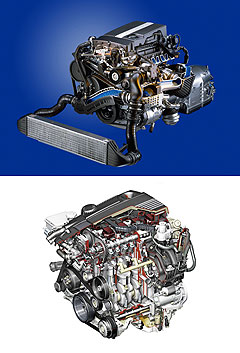Make / Model Search
News - Mercedes-BenzBenz slams local high-sulphur petrolSulphur so good: Australia has adopted low-sulphur diesel to enable the import of the latest fuel-efficient vehicles, but petrol standards lag behind. Fuel consumption higher on some Mercedes petrol engines in Oz due to sulphur levels8 May 2012 MERCEDES-BENZ is unable to offer the most efficient versions of some four-cylinder and V6 petrol engines in Australia due to the high sulphur content of local fuel. Mercedes-Benz Australia product manager Gordon Jones told GoAuto the company has to fit homogenous direct injection (DEH) systems instead of the more efficient stratified direct injection (DES) system to cars destined for high-sulphur markets like Australia. He said that, although fuel economy suffers, power and torque outputs are unaffected by the alternative injection technology because the company’s DES systems switch to DEH mode under greater load or throttle openings. DES comes into play when the engine is under light load, such as at cruising speed. Mr Jones explained that DES works in regions like Europe and Japan where low-sulphur fuel is commonplace, but said the injection systems for larger engines, such as V8s developed primarily for the North American market, are unchanged because fuel there also has high sulphur levels. Unlike diesel, which has had a mandatory maximum sulphur content of 10 parts per million in Australia since 2009, there is no legislation in place to force the introduction of low-sulphur petrol, which would require significant investment by the oil refineries. Mercedes argues that higher fuel consumption results in higher CO2 emissions, so if Australia’s goal of reducing the transport carbon footprint is to be realised, it follows that adopting low-sulphur fuel – as has taken place in regions such as Europe, where sulphur is limited to 10ppm across all fuels – could be a key step in the process. In Australia, the Fuel Quality Standards Act 2000 set a maximum of 150ppm for regular unleaded since 2005 and 50ppm for premium unleaded since 2008. DES can tolerate sulphur content of up to 50ppm, although at this level its efficiency benefits are reduced with prolonged use. In March 2010, the Australian petroleum industry told the federal government it did not support proposed changes to the fuel quality standards to make it easier for some vehicle manufacturers to achieve the upcoming Euro 5 and 6 emissions standards that will be introduced here starting from November 2013.  At that time, the FCAI reasoned that, because so many cars sold in Australia are imported, steps should be taken to harmonise fuel standards with Europe. At that time, the FCAI reasoned that, because so many cars sold in Australia are imported, steps should be taken to harmonise fuel standards with Europe.Mr Jones agreed that regions like Europe are leading the way with reduced vehicle CO2 emissions while the rest of the world undoes some of the good by lagging behind due to factors such as fuel quality and less stringent legislation. “For the Australian market, we don’t have the European issue where you have to produce lower CO2 emissions at the moment,” he said. “But it could change for us once the carbon tax bites or something else happens that will apply the pressure.” DES keeps the combustible fuel/air mixture close to the spark plug, leaving the rest of the combustion chamber to be filled with pure intake air or recirculated exhaust gases, resulting in a leaner burn and reduced fuel consumption. However, the higher proportion of air increases the chamber’s nitrogen content, which under combustion leads to higher levels of polluting nitrous oxides (NOx), requiring a special type of catalytic converter that does not work well with high-sulphur fuel. These catalytic converters can purge themselves of excess sulphur, but this requires the engine to revert to DEH combustion, which would happen frequently if subjected to Australian levels of sulphur, meaning the fuel consumption advantage of the more expensive DES system is lost. Mr Jones said no engineering work takes place in Australia to test using local petrol as the fuel is made to certain standards, and he is not aware of other car-makers that apply different fuel injection systems on their Australian-delivered cars. He said Australia’s ageing oil refinery infrastructure posed one challenge compared with some developing countries with brand new refineries that are better at reducing sulphur, but the mixture of imported and locally produced fuels entering the local market still pose a challenge. “There are all sorts of issues that raise themselves because fuel is inconsistent and that is one of the dilemmas that car companies face because they have so many variations of the same engine to suit the various fuel qualities and standards throughout the world.” Mr Jones agreed there is a chicken-and-egg scenario to overcome before low-sulphur fuel becomes the norm in Australia. “The (local) refineries would have to make a big investment because removing sulphur from petrol is the most difficult and expensive process and the government will not mandate for it.” He also said the Australian preference for larger wheel and tyre combinations also harms fuel efficiency, but that low rolling-resistance tyres go some way to redressing the balance.  Read more8th of May 2012  Downsizing the key to Benz growthMercedes-Benz takes aim at new customers with more-compact luxury models20th of June 2011  Australian government gets serious on E85Canberra proposes quality and retail standards for ethanol-based E85 bio-fuel21st of February 2011  Luxury car buyers switch to diesel powerBMW, Audi reach record diesel sales in 2010 |
Click to shareMercedes-Benz articlesResearch Mercedes-Benz Motor industry news |










Facebook Twitter Instagram